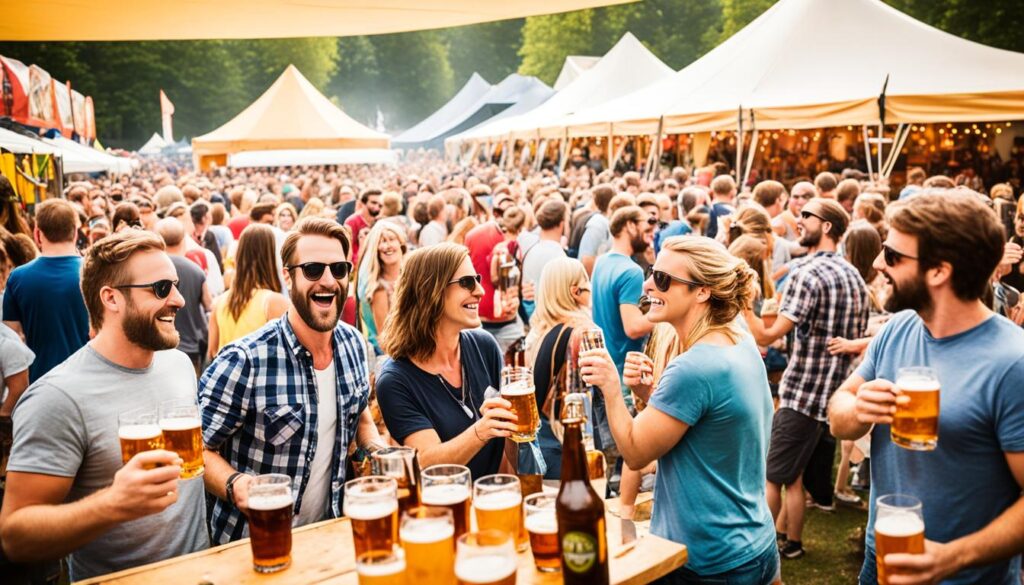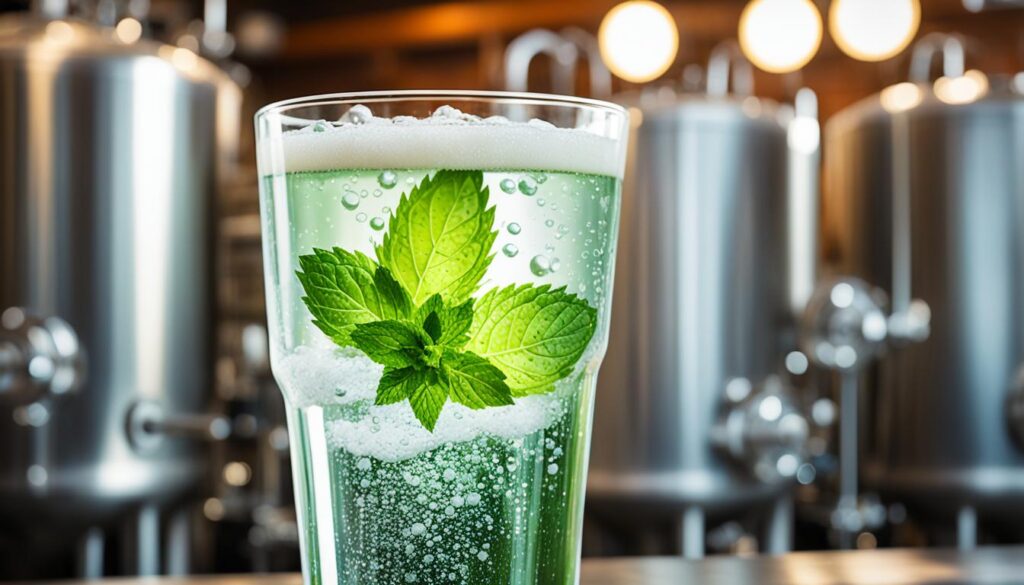Are microbreweries going out of style? Is the craft beer trend fizzling out?
According to recent data, the craft brewing industry experienced a decline in sales in the first half of 2023. But does this mean that small batch brewing and local breweries are losing their appeal? Not at all!
In fact, microbreweries are finding new and exciting ways to adapt and thrive in the ever-changing market. They are tapping into trends that are revolutionizing the brewing industry, ensuring that they stay relevant and continue to provide unique experiences for beer enthusiasts.
In this article, I will take you through the top trends and tips for microbreweries that will help you navigate the current landscape and stand out from the competition. From focusing on crowd-pleasing beverages and food options to exploring non-alcoholic alternatives and forming alliances, there are plenty of strategies that can lead to success.
Key Takeaways:
- Microbreweries are seeking ways to adapt and refine their approaches in the face of changing consumer preferences.
- Taprooms are putting a premium on service and hospitality to enhance the customer experience.
- Breweries are getting more creative with festivals and events to attract consumers.
- Non-alcoholic and mindful-drinking options are gaining traction as people seek healthier alternatives.
- Breweries are consolidating and forming alliances to share resources and survive in a competitive marketplace.
Contents
Taprooms Put a Premium on Service and Hospitality
Taprooms have come a long way from being simple places to grab a beer. They have transformed into full-service bars and restaurants, with brewery owners realizing the importance of providing a top-notch customer experience. Today, people are not just looking for good beer; they want a good overall experience that combines great drinks with excellent service and hospitality.
Investing in internal operations, such as improving service standards, can be a low-cost tactic for boosting a taproom’s appeal. By focusing on service and hospitality, taprooms can create a welcoming atmosphere that keeps customers coming back. After all, a positive consumer experience is crucial for building customer loyalty and growing a strong customer base.
One example of a taproom that excels in service and hospitality is Alternate Ending Beer Co. located in New Jersey. This taproom goes above and beyond to cater to every possible customer. They offer gluten-free and vegetarian dining options, as well as a variety of cocktails and non-alcoholic drinks. Additionally, their menu is designed to engage all ages, with coloring activities for kids. The attention to detail and commitment to customer satisfaction make Alternate Ending Beer Co. a standout in the industry.
Service and hospitality are more than just buzzwords; they are essential components of a successful taproom. When customers feel welcomed and taken care of, they are more likely to have a memorable experience and become repeat visitors. By prioritizing service and hospitality, taprooms can create a loyal customer base that will drive their business forward.
Key Elements of a Customer-Focused Taproom
| Elements | Description |
|---|---|
| 1. Welcoming Atmosphere | Create a warm and inviting space that makes customers feel comfortable and at home. |
| 2. Friendly and Knowledgeable Staff | Hire staff members who are passionate about beer and can provide excellent customer service. |
| 3. Diverse Beverage Options | Offer a wide selection of beers, cocktails, and non-alcoholic drinks to cater to different preferences. |
| 4. Food Pairing Options | Provide food options that complement the beer selection, such as appetizers, pizzas, and burgers. |
| 5. Engaging Activities | Organize events, live music, and games to keep customers entertained and encourage socialization. |
Creating a customer-focused taproom goes beyond serving great beer. It requires a commitment to service and hospitality that enhances the overall customer experience. So the next time you visit a taproom, pay attention to how they prioritize service and hospitality, and see how it elevates your enjoyment of the beer.
Breweries Get More Creative With Festivals and Events
Enticing drinkers to attend beer festivals and events can be challenging, especially in a post-COVID world. Breweries and event organizers are getting more creative in their approach to attract consumers.
For example, StormBreaker Brewing in Oregon rebooted its Brewstillery Fest, which paired local distillers and brewers for spirit-and-beer pairings. The Snallygaster Festival in Washington, D.C., combines rare beers with wine, cocktails, and live music, while Barrel & Flow Fest in Pittsburgh centers around Black brewers, musicians, artists, and nonprofits.
Breweries are also hosting their own festivals, such as West Sixth Brewing’s annual IPA festival. In particular, there is a growing interest in lagers, with breweries like Bagby Beer in California running the Low & Slow celebration and Buoy Beer in Oregon producing the Lager Fest.
Top Breweries with Creative Beer Festivals and Events:
| Brewery | Event/Festival | Location |
|---|---|---|
| StormBreaker Brewing | Brewstillery Fest | Oregon |
| Snallygaster Festival | Washington, D.C. | Rare beers, wine, cocktails, and live music |
| Barrel & Flow Fest | Pittsburgh | Black brewers, musicians, artists, and nonprofits |
| West Sixth Brewing | Annual IPA Festival | Kentucky |
| Bagby Beer | Low & Slow Celebration | California |
| Buoy Beer | Lager Fest | Oregon |

These innovative festivals and events not only showcase the breweries’ creative offerings but also provide unique experiences for beer enthusiasts. From collaboration with distilleries to celebrating different beer styles, breweries are continuously pushing boundaries to create memorable experiences for attendees.
More Brewers Pursue Non-Alcoholic and Mindful-Drinking Options
With the expanding non-alcoholic category, brewers are embracing the opportunity to cater to consumers’ growing demand for non-alcoholic and mindful-drinking options. By leveraging their brand equity, breweries are introducing non-alcoholic versions of popular beers and hard seltzers, widening their product portfolio.
Non-alcoholic beer is currently driving the growth in this category, accounting for a significant 86.1% share of the segment. This is followed by non-alcoholic wine with an 11.2% share and non-alcoholic spirits with a 2.7% share. The market for non-alcoholic beverages is experiencing remarkable growth, reflecting the shift in consumer preferences towards healthier alternatives.
In response to this demand, breweries are also exploring other innovative options such as hop-infused beverages like hop water. Hop water provides a refreshing and flavorful alternative to traditional beer and can appeal to consumers even outside of typical beer-drinking hours.

Brooklyn Brewery, a renowned name in the industry, has taken a stake in Hoplark, a company known for producing non-alcoholic hopped teas and sparkling water. This strategic partnership allows Brooklyn Brewery to tap into the booming non-alcoholic beverage market and cater to the increasing demand among consumers.
Mindful drinking extends beyond just the beverage itself. Breweries like Westbound & Down Brewing are embracing mindful practices by packaging their popular barrel-aged beers in smaller cans. This approach not only offers consumers more control over their drinking experience but also reduces wastage, emphasizing sustainability.
The growing popularity of non-alcoholic options has prompted retailers to allocate more shelf space to cater to this trend. As a result, consumers have a wider selection of non-alcoholic and mindful-drinking choices, allowing them to enjoy the social aspects of drinking while making conscious decisions about their alcohol consumption.
Quick Facts:
- Non-alcoholic beer accounts for 86.1% of the non-alcoholic category, followed by non-alcoholic wine (11.2%) and spirits (2.7%).
- Breweries are exploring hop-infused beverages like hop water to appeal to consumers outside of traditional beer-drinking hours.
- Brooklyn Brewery has invested in Hoplark, a company specializing in non-alcoholic hopped teas and sparkling water.
- Breweries like Westbound & Down Brewing are packaging barrel-aged beers in smaller cans to promote mindful drinking and sustainability.
- Retailers are allocating more shelf space to accommodate the growing demand for non-alcoholic and mindful-drinking options.
Increased costs and competition, coupled with changing consumer tastes, have posed significant challenges for midsize breweries. In order to navigate this ever-evolving landscape, breweries are actively seeking opportunities to cut costs and optimize their operations. One strategy that is gaining traction is consolidation and resource-sharing among breweries.
These challenging times have prompted brand houses like Wings & Arrow and Ninkasi Brewing to merge, creating the powerful entity known as Great Frontier Holdings. Similarly, Smuttynose owner Finestkind Brewing successfully acquired Five Boroughs Brewing, further solidifying their position in the market. By joining forces, breweries can consolidate their operations, streamline their processes, and benefit from economies of scale.
Midsized breweries are recognizing the need to explore alternative growth strategies to ensure their survival in the highly competitive marketplace. Collaboration and resource-sharing have emerged as essential tactics to tide over the challenges faced by breweries. By pooling their resources and expertise, breweries can overcome obstacles, sustain their business operations, and continue to deliver exceptional beers to their loyal customers.